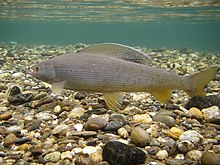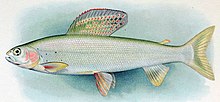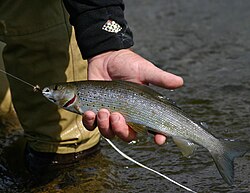Arctic grayling
| Arctic grayling | |
|---|---|

| |

| |
| Scientific classification | |
| Domain: | Eukaryota |
| Kingdom: | Animalia |
| Phylum: | Chordata |
| Class: | Actinopterygii |
| Order: | Salmoniformes |
| Family: | Salmonidae |
| Genus: | Thymallus |
| Species: | T. arcticus
|
| Binomial name | |
| Thymallus arcticus Pallas, 1776
| |
| Synonyms[2] | |
|
previous scientific names
| |
The Arctic grayling (Thymallus arcticus) is a species of freshwater fish in the salmon family Salmonidae. T. arcticus is widespread throughout the Arctic and Pacific drainages in Canada, Alaska, and Siberia, as well as the upper Missouri River drainage in Montana. In the U.S. state of Arizona, an introduced population is found in the Lee Valley and other lakes in the White Mountains. They were also stocked at Toppings Lake by the Teton Range and in lakes in the high Uinta Mountains in Utah, as well as alpine lakes of the Boulder Mountains (Idaho) in central Idaho.
Taxonomy
The scientific name of the Arctic grayling is Thymallus arcticus. It was named in 1776 by German zoologist Peter Simon Pallas from specimens collected in Russia. The name of the genus Thymallus first given to grayling (T. thymallus) described in the 1758 edition of Systema Naturae by Swedish zoologist Carl Linnaeus originates from the faint smell of the herb thyme, which emanates from the flesh.[3]
Description
Range

Arctic grayling are widespread in Arctic Ocean drainages from
Life cycle
Several life history forms of Arctic grayling occur:
The Arctic grayling occurs primarily in cold waters of mid-sized to large rivers and lakes, returning to rocky streams to breed. The various subspecies are omnivorous. Crustaceans, insects and insect larvae, and fish eggs form the most important food items. Larger specimens of T. arcticus become piscivorous and the immature fish feed on zooplankton and insect larvae.

Spawning takes place in the spring. Adult fish seek shallow areas of rivers with fine, sand substrate and moderate current. Males are territorial and court females by flashing their colourful dorsal fins; the fins are also used to brace receptive females during the vibratory release of
Conservation
Arctic grayling are considered a secure species throughout their range.[10] Although some populations at the southern extent of its native range have been extirpated,[11] it remains widespread elsewhere and is not listed on the IUCN Red List of threatened species.
The fluvial
The Arctic grayling is economically important; it is a "key subsistence species"
Notes
- Citations
- . Retrieved 19 November 2021.
- ^ "Synonyms of Thymallus arcticus (Pallas, 1776)". Fishbase. Retrieved 2014-02-26.
- ^ Ingram, A.; Ibbotson, A.; Gallagher, M. "The Ecology and Management of the European Grayling Thymallus thymallus (Linnaeus)" (PDF). East Stoke, Wareham, U.K.: Institute of Freshwater Ecology. p. 3. Retrieved 2014-02-27.
- ^ "Nonindigenous Aquatic Species Arctic Grayling". U.S. Geological Survey. Retrieved 2014-02-27.
- ISBN 978-1-59921-203-6.
- ^ "Thymallus arcticus". Integrated Taxonomic Information System. Retrieved 2014-02-27.
- ^ Fishing Wyoming Kenneth Lee Graham
- ^ "Thymallus arcticus". Utah Division of Wildlife Resources. Archived from the original on November 28, 2016. Retrieved May 21, 2017.
- ^ "Arctic Grayling: Sailfish Of The North". www.denali.org. Retrieved 19 November 2023.
- ^ "Thymallus arcticus". Natureserve Explorer. Retrieved 2014-02-28.
- ^ House, Kelly (October 12, 2023). "Gone nearly a century, Michigan anglers can again catch Arctic grayling | Bridge Michigan". www.bridgemi.com. Retrieved 19 November 2023.
- ^ "arctic grayling web". www.fws.gov. Archived from the original on 2007-08-16.
- ^ a b George, Craig; Moulton, Larry; Johnson, Michele (2009). A Field Guide to the Common Fishes of the North Slope of Alaska (PDF) (Report). Barrow, Alaska, USA. p. 98. Archived from the original (PDF) on November 12, 2017. Retrieved November 11, 2017.
{{cite report}}: Unknown parameter|agency=ignored (help)
- Sources
- Froese, Rainer; Pauly, Daniel (eds.) (2012). "Thymallus arcticus" in FishBase. February 2012 version.
- FWS (2004). U.S. Fish and Wildlife Service Species Assessment and Listing Priority Assignment Form for fluvial Arctic grayling (distinct population segment of the Upper Missouri River), commonly called Montana Arctic grayling. November 30, 2004.
External links
- EcoRover blog about Big Hole River grayling
- Pat Munday's rating of Big Hole Watershed Committee effectiveness in Big Hole River grayling restoration
- Length and age at maturity of Arctic grayling in the Snake River during 2003 / by Alfred L. DeCicco and Andrew D. Gryska. Hosted by Alaska State Publications Program.
- Summer abundance of Arctic grayling in the Chena River, 2005 by Klaus G Wuttig; Steven M Stroka; Alaska. Division of Sport Fish.; Alaska. Division of Commercial Fisheries. Hosted by Alaska State Publications Program.

